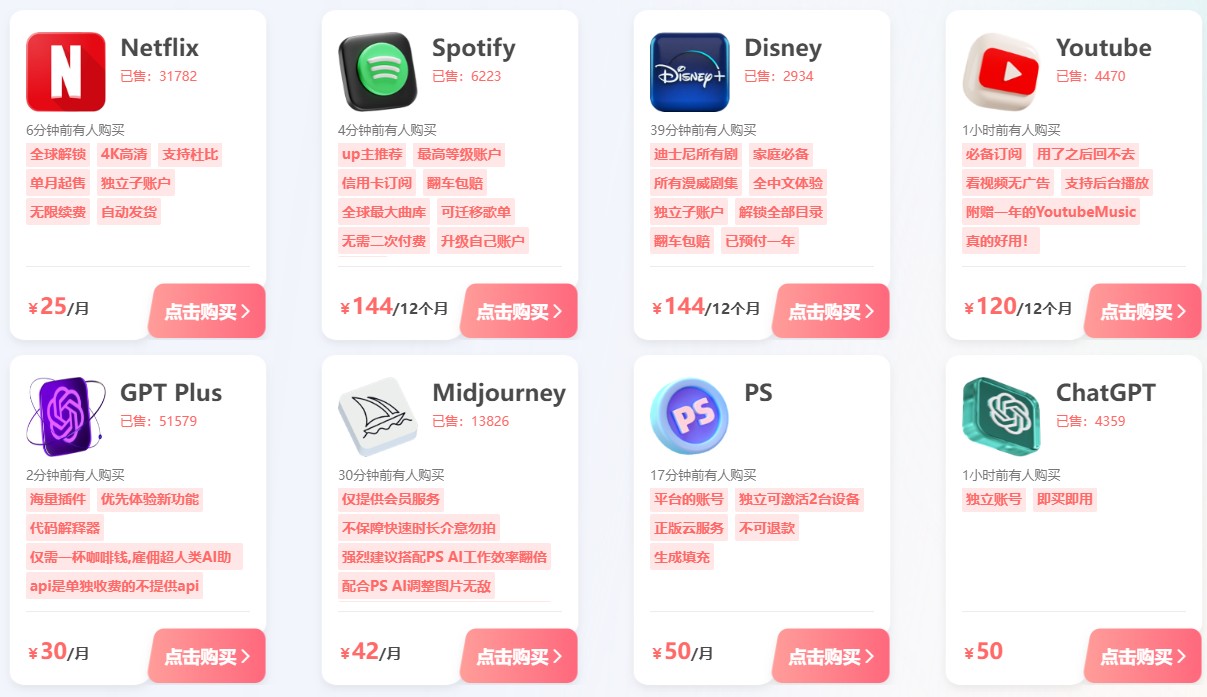Article directory
✨Unleash your imagination with DALL-E🚀! This revolutionary AI Image generation tool allows you to create stunning images with text🎨.
Just enter your ideas and DALL-E will turn them into life-like works of art!
From dreamy landscapes to stunningpersonportrait, the possibility isunlimitedof.
Join the DALL-E painting magic circle and start your artistic journey!
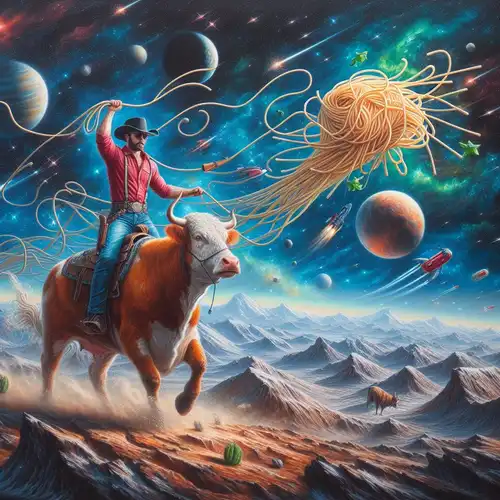
Recently, the field of artificial intelligence (AI) has made remarkable progress.ChatGPT Not only does it excel in text creation, but our AI stage gradually expands beyond pure text.
What is DALL-E?
DALL-E is a revolutionary AI system that generates images based on text descriptions.
DALL-E is an important milestone in artificial intelligence creativity, and the latest version, DALL-E 3, is even more powerful.
In this guide, we'll take a closer look at what DALL-E is, how it works, its areas of application, and tips for using it to generate great visual content.
The concept sounds simple, but for best results, you need to follow these tips for authentic and accurate search results! To ensure you get the most authentic and accurate search results, we provide you with the following tips and tricks.
Before using DALL-E, there are three housekeeping rules you need to understand:
Since you technically created the idea for your artwork, you are the artist by default, although the image will be downloaded with DALL-E 2's color watermark.
There are limits to what you can create. For example, DALL-E 2's content policy prohibits harmful, deceptive, or political content. To prevent abuse, some search terms for public figures, such as Taylor Swift, are disabled. While not all celebrities violate content policies, their faces are often distorted for safety.
Credit limit for DALL-E 2: Users who register and create an account via email before April 2023, 4 can receive 6 free credits, expiring and renewing each month. For example, I signed up on September 15, 2022, so I get 9 free credits every month, which renews automatically. Note that the free credits are not rollable, so even if I don't create art for three months, I can't accumulate 25 credits. New users who have just created an account no longer enjoy the same free credit benefit and must purchase at least 15 credits for $60. Users can purchase DALL-E credits separately through labs.openai.com, which are billed separately from the DALL-E API.
Credits are only redeemable after they are entered and generated, searches that are ultimately not generated due to content policy violations will not be deducted from the free credit. You can click on your profile icon in the upper right corner of the search interface to see how much credit you have left each month, and you can choose to buy more, starting at $115 for 15 credits.
How to use DALL-E to generate pictures?
DALL-E is one of the most powerful artificial intelligence tools currently on the market.
This is an artificial intelligence image generator developed by the OpenAI team behind ChatGPT. It uses a technology called "generative artificial intelligence" to create original images from scratch based on text prompts.
For example, if you enter the text "an avocado chair with a red colored monkey”, DALL-E will generate new images of this strange object.
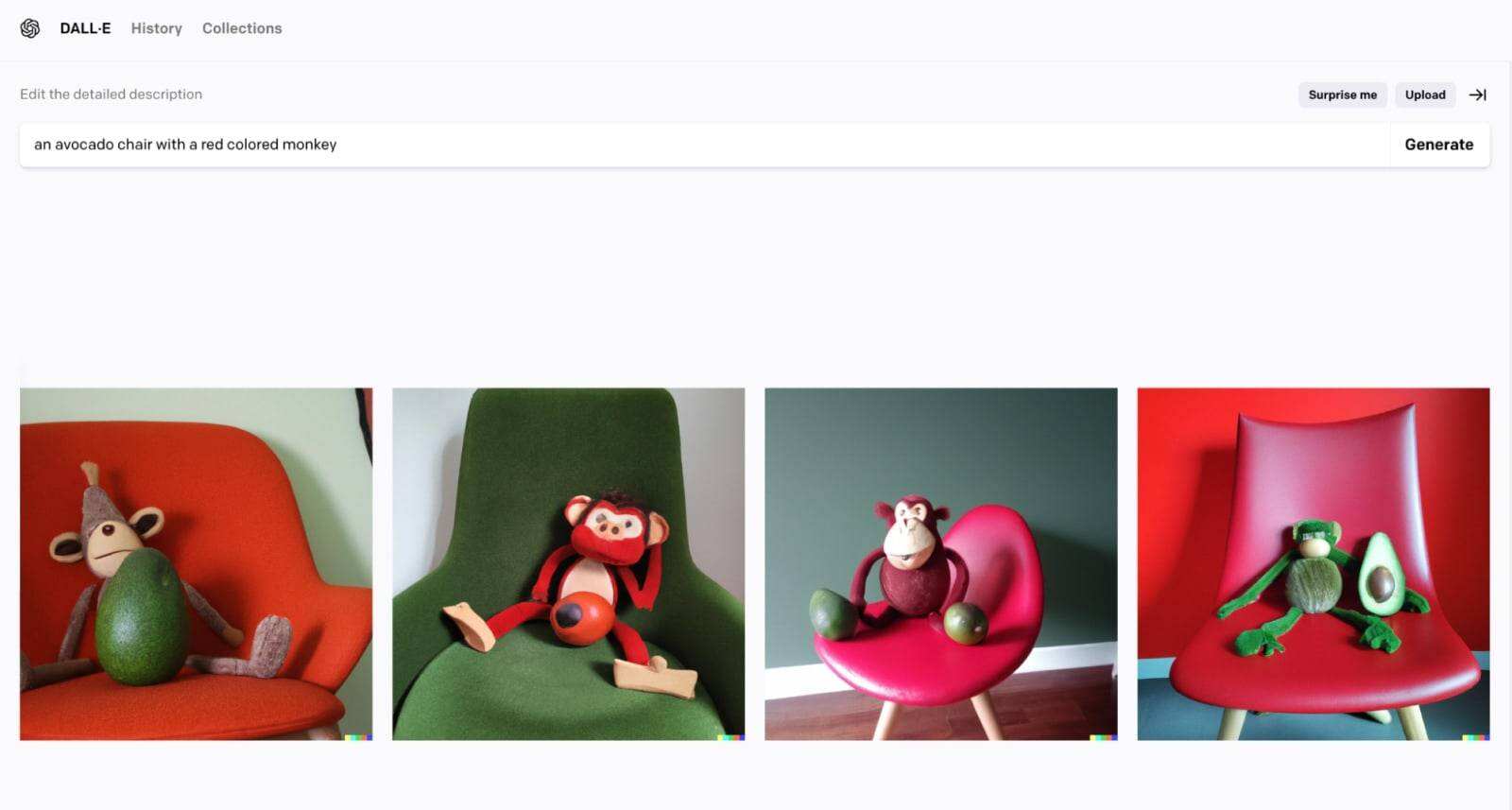
Rather than simply cutting and collaging parts of an image, it's actually "imagining" what you're describing. The more detailed your description, the more refined the resulting image will be.
It is worth noting that the name "DALL-E" is a homophony of the surrealist artist Salvador Dali and Pixar's friendly robot character WALL-E. This hints at how DALL-E combines art and technology to create fantastic visual effects directly from text descriptions.
This is the wonder of DALL-E, which represents a leap in artificial intelligence creativity.
While humans can easily imagine things through words, computers used to be unable to do so, especially not in such a vivid way. DALL-E realizes the practical imagination and problem-solving capabilities inherent in computers, opening up exciting possibilities for graphic design, image templates, web page layouts, and more.
How does DALL-E work?
How does DALL-E cast its magic? As mentioned earlier, it uses a technology called “generative artificial intelligence.” Let’s take a closer look.
Generative AI models
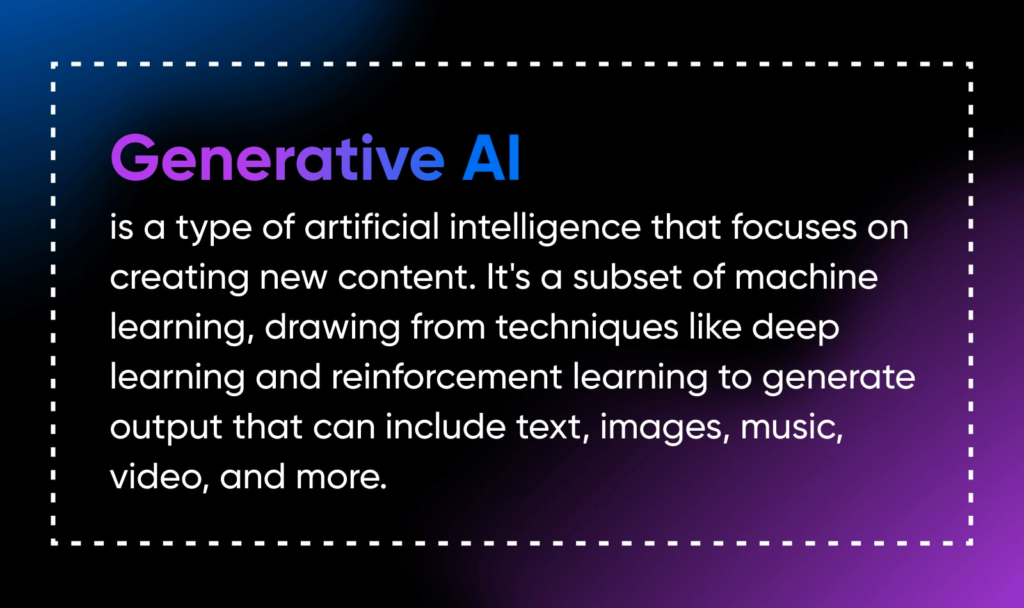
Unlike most task-specific AI, generative AI models are not specialized to perform a specific task.
Instead, they are trained on massive sets of images, text, and other data to develop a deep understanding of the relationships between various concepts.
This enables them to generate new output that is highly realistic and accurately matches the prompts.
For example, an AI trained only on photos of cats would not be able to imagine a novel animal like "flamingo-lion." Trained on millions of images of a variety of animals, humans, toys, and more, the generative model can combine this knowledge to convincingly generate a flamingo-lion hybrid based on prompts.
In the latest version of DALL-E 3, this ability to create completely new things has been further demonstrated. The new version demonstrates a higher level of accuracy in interpreting cues, capturing subtle differences and details that previous models were unable to capture.
Compared with previous artificial intelligence generators, DALL-E 3 is no longer prone to unexpected results when receiving complex instructions. Instead, it demonstrates a superior understanding of language that enables it to imagine novel scenarios and characters that exceed expectations from text-to-image generative models.
With DALL-E 3, the connection between language and image is even closer, with the ability to interpret the context of cues rather than just mechanically generate images. This makes the generated images closer to the user's expectations.
Next, let’s take a deeper look at how DALL-E’s generation architecture works.
How does DALL-E's generative architecture work?
The key to enabling DALL-E to generate images from text lies in its specially designed neural network architecture:
Large data sets:
DALL-E is trained on billions of image-text pairs, which enables it to learn visual concepts and their relationship to textual content or spoken language. This massive data set provides it with a broad understanding of the world's knowledge.
Hierarchical structure:
The network has a hierarchical representation from high-level concepts to details. The top layers understand broad categories (such as birds), while the bottom layers recognize subtle attributes (such as beak shape, color, and position on the face).
Text encoding:
Using this knowledge, DALL-E is able to convert written words into a mathematical representation of the text. For example, when we type "Flamingo-lion", it knows what a flamingo is, what a lion is, and is able to combine the different characteristics of the two animals. Through this translation, textual input can produce visual output.
This advanced architecture enables DALL-E to accurately generate creative and coherent images following textual cues.
Now, we understand the technical complexities, but for the end user, using DALL-E is very simple.
Just enter the prompts and generate stunning images.
Language models and DALL-E
An important component of the DALL-E architecture is the GPT (Generative Pretrained Transformer) language model. These models play a key role in interpreting and refining cues.
The GPT model is good at grasping the context and subtle differences of language. When a prompt is entered, the GPT model not only reads the words but also understands the intent and subtle meaning behind them. This understanding is crucial for translating abstract or complex ideas into visual elements that DALL-E’s image generation portion can exploit.
If the initial hint is unclear or too broad, the GPT model can help refine or expand the hint. Through extensive training on language and a variety of topics, it can infer which details might be relevant or interesting to an image, even if not explicitly mentioned in the original prompt.
The GPT model can also identify possible errors or ambiguities in the hints. For example, if a prompt contains factual inconsistencies or confusing language, the model can correct the error or seek clarification, ensuring the final input to the image generator is as clear and accurate as possible.
Interestingly, the role of GPT is not limited to understanding and refinement, it can also add a layer of creativity. With extensive training, it can come up with unique or imaginative interpretations of cues, pushing the limits of image generation.
In essence, the GPT language model is an intelligent intermediary between user input and DALL-E's image generation capabilities. Not only do they ensure prompts are understood accurately, they are also enriched and optimized to produce the most relevant and creative visual output.
What is DALL-E used for?
The application fields of DALL-E are diverse. It can be used to create a variety of visual elements, providing creative and design support for different industries and uses.
graphic design:
DALL-E can generate unique and compelling training on images, text, and other data sets to develop a deep understanding of the relationships between various concepts.
In this way, they are able to generate novel outputs that are highly realistic and accurately match the provided cues.
For example, an AI trained only on photos of cats would not be able to imagine novel animal species like "flamingos and lions."
And through training on millions of images, text, and audio of various animals, humans, toys, and more, the generative model can combine these learning results to convincingly generate hybrids such as "flamingos and lions."
In the latest version of DALL-E 3, this ability to create new things is even more powerful. It demonstrates new talents in accurately interpreting cues and capturing subtle differences and details that previous models were unable to capture.
Compared with previous artificial intelligence generators, DALL-E 3 shows better understanding capabilities when receiving complex instructions. While previous generators often produced unexpected results when processing complex prompts, DALL-E 3 demonstrates excellent understanding of language, allowing it to imagine novel scenarios and characters beyond text-to-image generation models. expectations.
With DALL-E 3, the connection between language and image is even stronger, so it can interpret the context of the prompt rather than just reading it from the script. The results generated may be very close to the user's needs.
Here's an example of a simple prompt: "Imagine a flamingo lion."
Image output:
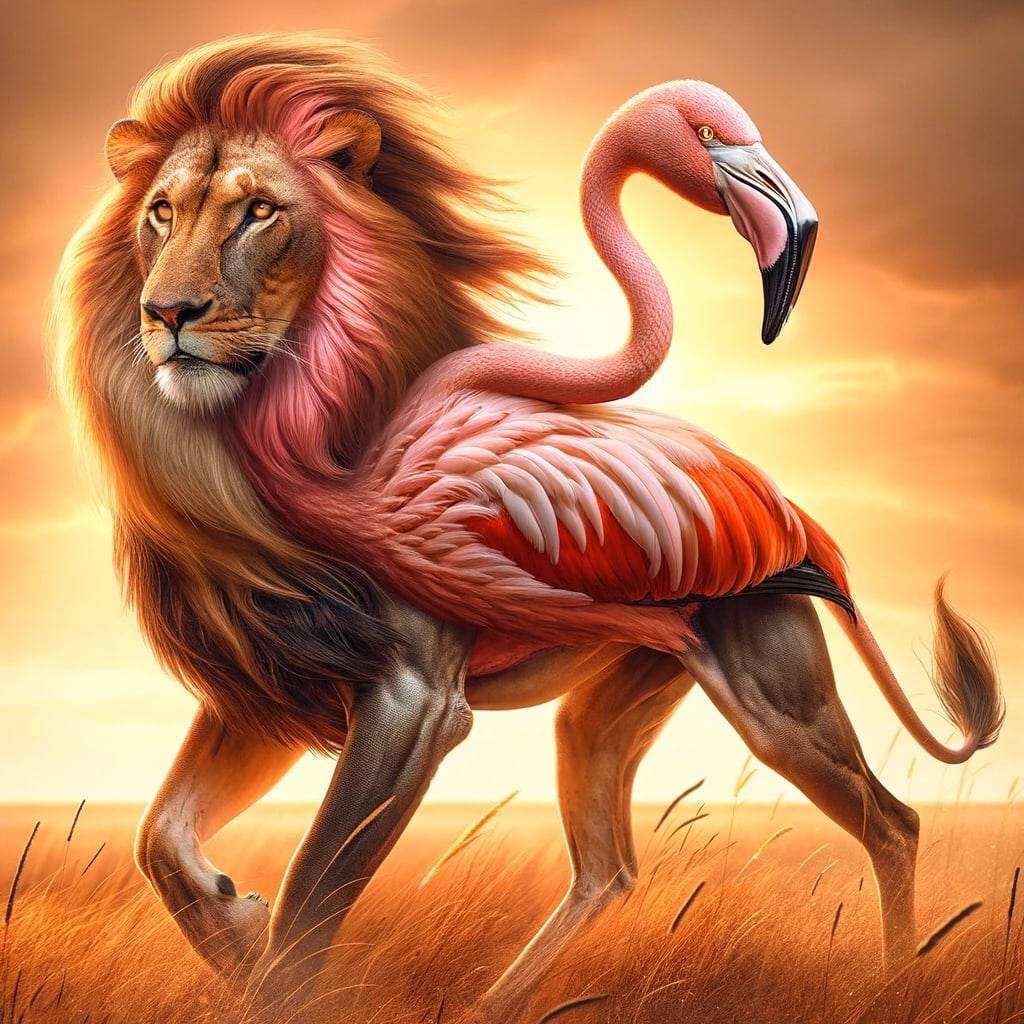
So, how is it achieved? This ability to “imagine” text stems from two key components of generative AI models:
Neural Networks:
Neural network is a hierarchical algorithm network that simulates the working principle of neurons in the human brain. It enables artificial intelligence to identify patterns and concepts in large data sets.
Machine learning algorithm:
These algorithms, such as deep learning, continue to improve neural networks’ understanding of data relationships.
Generative models build rich conceptual understanding of the world by training on huge data sets. Accurate prompts can remix these learning outcomes to produce never-before-seen output.
How DALL-E's Generative Architecture Works
DALL-E is able to generate images from text thanks to its specially designed neural network architecture:
Large data sets:
DALL-E is trained on billions of image-text pairs, which allows it to learn visual concepts and their association with textual content or spoken language. This massive data set provides it with extensive knowledge of the world.
Hierarchical structure:
The network is represented hierarchically, from high-level concepts to details. The top layers understand broad categories (like birds), while the bottom layers recognize subtle attributes (like beak shape, color, and position on the face).
Text encoding:
With this knowledge, DALL-E is able to convert written words into mathematical representations. For example, when we type "flamingo lion", it knows what a flamingo and a lion are and is able to combine the different characteristics of the two animals. Through this kind of translation, textual input can produce visual output.
This advanced architecture helps DALL-E generate creative and coherent images based on precise text cues.
Now, we know that the technical issues can be quite complex, but for the end user, the operation is very simple.
Just provide tips and generate stunning images.
Language models and DALL-E
An important component of DALL-E's architecture is the GPT (Generative Pretrained Transformer) language model. These models play a key role in interpreting and refining cues to optimize image generation.
GPT models are good at understanding the context and nuances of language. When prompted, the GPT model is able to not only recognize words but also understand the intent and subtle meaning behind them. This understanding is crucial for translating abstract or complex ideas into visual elements that DALL-E’s image generation portion can exploit.
If the initial prompt may be vague or too broad, the GPT model can help refine or expand the prompt. Through extensive training on language and a variety of topics, it can infer what details might be relevant or interesting to an image, even if they weren't explicitly mentioned in the original prompt.
The GPT model is also able to identify possible errors or ambiguities in the hints. For example, if a prompt contains factual inconsistencies or confusing language, the model can correct the error or seek clarification, ensuring the final output of the image generator is as clear and accurate as possible.
Interestingly, the role of GPT is not limited to understanding and refinement, it can also add a layer of creativity. With extensive training, it can come up with unique or imaginative interpretations of cues, pushing the creative limits of image generation.
In essence, the GPT language model is an intelligent intermediary between user input and DALL-E's image generation capabilities. Not only does it ensure prompts are understood accurately, but they are also enriched and optimized to produce the most relevant and creative visual output.
Application of DALL-E
DALL-E is more than just a cool technology demonstration, it has many practical applications.
1. Creative design:
Designers can easily realize their creative ideas with DALL-E. Whether it is a unique product concept, advertising image, or artistic work, DALL-E can inject new inspiration into the design field.
2. Content Creation:
Writers and creators can use DALL-E to generate visual elements for their stories, articles or comics. This helps to enrich their creations and make them more attractive.
3. Visual merchandising:
Brands and marketing teams can use DALL-E to create eye-catching ads, posters and other promotional materials. This helps increase brand awareness and attract more target audiences.
4. Educational assistance:
Educators can use DALL-E to generate images to make teaching materials more lively and interesting. Students can better understand complex concepts through visual elements.
5. Virtual scene creation:
Film and television producers and game developers can use DALL-E to generate unique scenes, characters and props to add color to their works.
This is just the tip of the iceberg of DALL-E, and its application areas are still expanding. It brings unprecedented creativity and efficiency to all walks of life.
If you register OpenAI in mainland China, a prompt will appear:OpenAI's services are not available in your country."▼
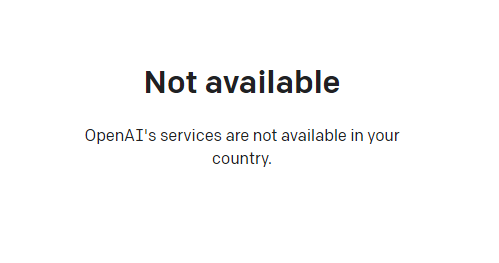
Because advanced features require users to upgrade to ChatGPT Plus to use,In countries that do not support OpenAI, it is quite difficult to open ChatGPT Plus, and you need to deal with complicated issues such as foreign virtual credit cards...
Here we would like to introduce you to an extremely affordable website that provides ChatGPT Plus shared room accounts.
Please click the link address below to register for Galaxy Video Bureau▼
Click the link below to view the Galaxy Video Bureau registration guide in detail ▼
Tips:
- IP addresses in Russia, China, Hong Kong, and Macau cannot register for an OpenAI account. It is recommended to register with another IP address.
Conclusion
In the wave of artificial intelligence, DALL-E is undoubtedly a dark horse. It demonstrates the extraordinary capabilities of artificial intelligence in image generation, providing powerful tools for creators, designers, and marketing professionals.
Through deep learning and advanced neural networks, DALL-E is not only able to understand textual prompts, but also creatively transform them into stunning visual content. Its generation process combines generative artificial intelligence and language models to provide users with a simple and powerful experience.
Whether it is creative design, content creation or marketing, DALL-E has injected new vitality into various industries. It is not only the pinnacle of technology, but also the source of unlimited creativity.
As technology continues to evolve, we can expect that future versions of DALL-E will bring more surprises and inject more vitality into the field of artificial intelligence.
Hope Chen Weiliang Blog ( https://www.chenweiliang.com/ ) shared "How to use DALL-E to create pictures?" AI text generates paintings, say goodbye to scumbag painting! 》, helpful to you.
Welcome to share the link of this article:https://www.chenweiliang.com/cwl-31503.html
To unlock more hidden tricks🔑, welcome to join our Telegram channel!
If you like it, please share and like it! Your sharing and likes are our continuous motivation!

